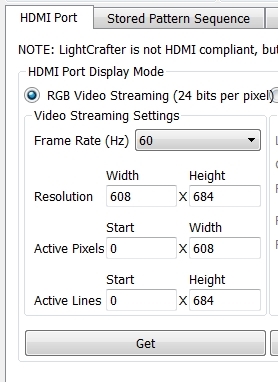Part Number: DLP3000
Hello again Forums,
As per my title, I am trying to use a Raspberry Pi to control the modulation of DMD mirrors to achieve a Hadamard filter set with a resolution of 608x684. I am working with the instrument shop in our department to figure it out the best we can. One thing I want to be sure of and I think a few forum posts have confirmed this, that any input video to the DMD will be modified to fill the screen as best as possible. If that were the case, I would imagine that the "monitor'output from the Pi would be easily converted. However, I have been seeing this :
The first link(if it works) is a short video where the pi is defaulting to a resolution of (some number I did not write down but the point is that it is just below the resolution of the DMD.)

The immediate attempt to fix was this second video, where the reolution was adjusted ( as of this posting I have been able to check the resolution of the Pi via a WinSCP/Putty terminal.) but it is noticeably worse.
My hope here is that someone would be able to confirm and or be able to know why the resolution mismatch is being an issue in this case.



